
5 Gentle Exercises to Relieve Back Pain
Back pain is a common problem that affects people of all ages and lifestyles. Whether it’s caused by a sedentary life, poor posture, or injury, chronic back pain can significantly impact one’s quality of life. While many people turn to pain medication or surgery to manage their pain, exercise has been proven to be an effective and non-invasive way to alleviate back pain.
Regular exercise can help reduce the risk of chronic back pain and strengthen the muscles that support the spine. When done correctly, exercise can also increase flexibility and mobility, making it easier to perform your daily activities and reduce the risk of future injuries. However, it’s important to note that not all exercises are suitable for everyone, and some may even exacerbate their existing pain or conditions.
Therefore, it’s crucial to consult with a medical professional before starting any new exercise routine, especially if you have a history of back pain or similar conditions. Your doctor or physical therapist can help you develop a safe and effective exercise program that meets your specific needs and goals.
In this article, we will discuss five gentle exercises that can help relieve back pain. These exercises are designed to be low-impact and easy to perform, making them suitable for newcomers and those with limited mobility. By incorporating these exercises into your daily routine, you can begin to strengthen your back muscles, improve your posture, and relieve chronic pain.
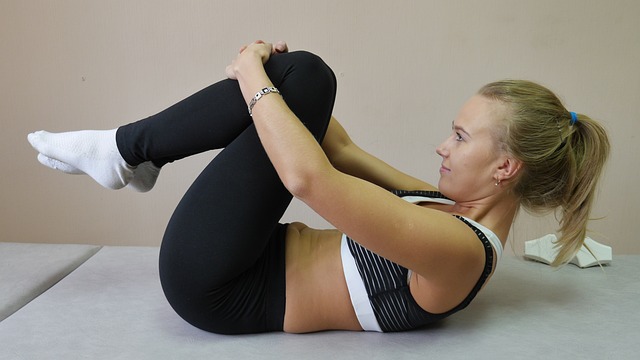
Exercise 1: Knee-to-Chest Stretch
Description The knee-to- chest stretch is a simple exercise that can help relieve pressure in the lower back muscles. It involves bringing one knee towards the chest while keeping the other leg extended on the ground.
Step- by- step instructions
- Lay on your back with your knees bent and your feet flat on the ground.
- Slowly bring one knee towards your chest, using both hands to gently pull the knee inwards. Keep the other leg extended on the ground.
- Hold the stretch for 15- 30 seconds, or as long as is comfortable.
- Slowly release the stretch and perform the same process with the other leg.
Benefits The knee- to-chest stretch can help alleviate lower back pain by stretching the muscles in the lower back, hips, and glutes. This exercise can also help improve flexibility and range of motion in the lower back.
Modification: For those with limited mobility, this stretch can be modified by using a towel or a starp to help pull the knee towards the chest. Alternately, the exercise can be performed while seated in a chair, by bringing one knee towards the chest and hugging it with both arms.
Note: It’s important to avoid this exercise if you have an injury or condition that makes it difficult to bring your knee towards your chest. If you experience pain or discomfort during this stretching exercise, stop immediately and consult with a medical professional.
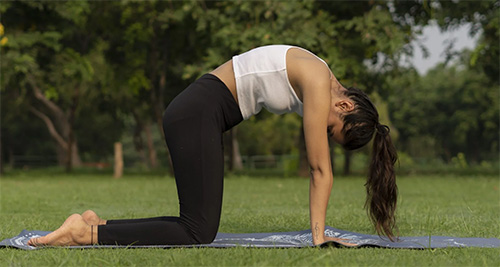
Exercise 2: Cat-Cow Stretch
Description The cat-cow stretch is a gentle yoga pose that can help alleviate tension in the spine and improve overall spinal mobility. It involves transitioning between a rounded, cat-like position and an arched, cow-like position.
Step- by- step instructions:
- Start on your hands and knees with your wrists directly under your shoulders and your knees directly under your hips.
- As you inhale, lift your head and tailbone towards the ceiling, arching your back and allowing your stomach to drop towards the ground.
- As you exhale, tuck your chin towards your chest and round your spine, drawing your belly button towards your spine.
- Repeat this movement, inhaling as you arch your back and exhaling as you round your spine. Move slowly and easily, focusing on your breathing and the sensations in your spine.
Benefits: The cat-cow stretch can help improve spinal mobility and reduce tension in the back, neck, and shoulders. It can also help improve posture and relieve stress.
Variations: For those with limited mobility, the cat-cow stretch can be modified by using a chair or wall for support. The exercise can also be done while seated in a chair, by rounding and arching the spine while seated and holding onto the sides of the chair.
Note: It’s important to avoid this exercise if you have a spinal injury or condition that makes it difficult to move your spine in this way. If you experience pain or discomfort during this exercise, stop immediately and consult with a medical professional.
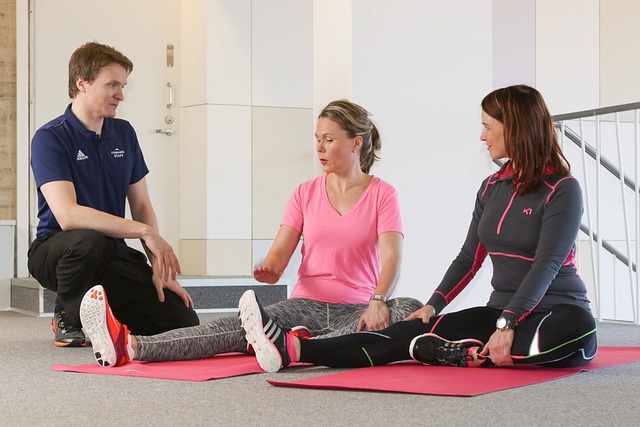
Exercise 3: Pelvic Tilt
Description: The pelvic tilt is a simple exercise that can help improve your core strength and flexibility in the lower back. It involves gently tilting the pelvis forwards and backwards while lying on the ground.
Step- by- step instructions:
- Lay on your back with your knees bent and your feet flat on the ground.
- Place your hands on your hips, with your fingers pointing towards your feet.
- Slowly tilt your pelvis forward, pressing your lower back into the ground and bringing your tailbone towards your knees.
- Hold the position for a few seconds, then release and tilt your pelvis backwards, arching your lower back away from the ground.
- Repeat this movement, focusing on the gentle tilting of the pelvis and the feeling in your lower back.
Benefits: The pelvic tilt can help strengthen the muscles in the lower back and core, improving overall stability and reducing the threat of back pain. It can also help improve posture and flexibility in the lower back.
Modifications: For those with limited mobility, the pelvic tilt can be modified by performing the exercise while seated in a chair, by gently rocking the hips forwards and backwards while seated. Alternately, the exercise can be performed while lying on a stability ball or rolled-up towel for more support.
Note: It’s important to avoid this exercise if you have a spinal injury or condition that makes it difficult to move your lower back in this way. If you experience pain or discomfort while performing this exercise stop immediately and consult with a medical professional.
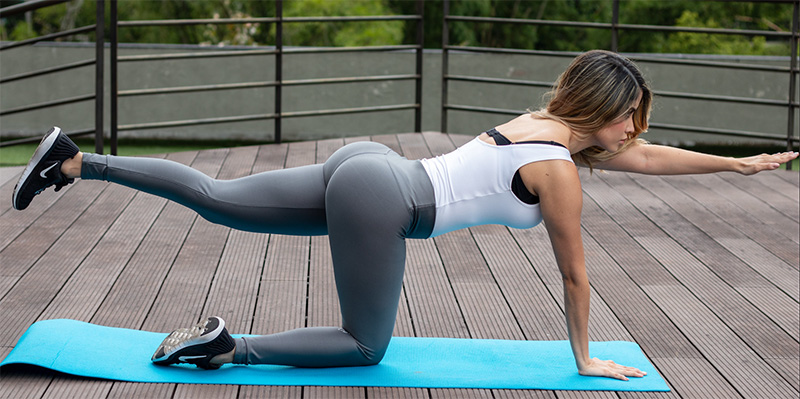
Exercise 4: Bird Dog
Description: The bird dog exercise is a classic core- strengthening exercise that can help improve stability and balance in the lower back. It involves extending one arm and the opposite leg while maintaining a stable, neutral spine.
Step- by- step instructions:
- Start on your hands and knees with your wrists directly under your shoulders and your knees directly under your hips.
- Engage your core muscles and extend your right arm and left leg out in front of you, keeping your spine in a neutral position.
- Hold the position for a few seconds, then return to the starting position.
- Repeat the movement with the opposite arm and leg, extending your left arm and right leg out in front of you.
Benefits: The bird dog exercise can help improve core strength and stability, as well as balance and collaboration. It can also help alleviate tension in the lower back and reduce the risk of back pain.
Modifications: For those with limited mobility, the bird dog exercise can be modified by reducing the range of motion or using a stability ball or other prop for more support. Alternately, the exercise can be performed while seated in a chair, by extending one arm and the opposite leg while seated.
Note: It’s important to avoid this exercise if you have a spinal injury or condition that makes it difficult to perform this movement. If you experience pain or discomfort during this exercise, stop immediately and consult with a medical professional.
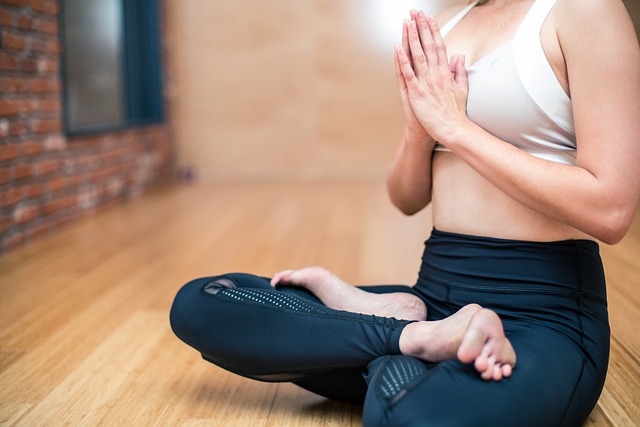
Exercise 5: Wall Angels
Description: The wall angels exercise is a gentle upper back and shoulder exercise that can help improve posture and reduce pressure in the upper body. It involves standing with your back against a wall and moving your arms up and down in a” snow angel” motion.
Step- by- step instructions:
- Stand with your back against a wall and your feet about 6 inches away from the wall.
- Raise your arms to shoulder height, with your elbows bent and your forearms resting against the wall.
- Slowly move your arms up and down in a” snow angel” motion, always keeping your forearms in contact with the wall.
- Move slowly and smoothly, focusing on the feeling in your upper back and shoulders.
- Repeat for 10- 15 reps, or as many as is comfortable for you.
Benefits: The wall angels exercise can help improve posture and reduce pressure in the upper back and shoulders. It can also help improve overall spinal mobility and reduce the risk of back pain.
Modifications: For those with limited mobility, the wall angels exercise can be modified by reducing the range of motion or using a stability ball or other mount for more support. Alternately, the exercise can be performed while seated in a chair, by making the same arm movements with a light weight or resistance band.
Note: It’s important to avoid this exercise if you have a shoulder injury or condition that makes it difficult to perform this movement. If you experience pain or discomfort during this exercise stop immediately and consult with a medical professional

Conclusion
Regular exercise is an effective and non-invasive way to alleviate back pain and improve overall spinal health. The five gentle exercises described in this article can help improve flexibility, strength, and improve stability in the back and reduce the risk of chronic pain. It’s important to note that not all exercises are suitable for everyone, and it’s important to consult with a medical professional before starting any new exercise routine.
Recap of the five exercises and their benefits
- Knee- to- chest stretch: Relieves pressure in the lower back muscles and improves inflexibility.
- Cat-cow stretch: Improves spinal mobility and reduces pressure in the back, neck, and shoulders.
- Pelvic Tilt: Strengthens the lower back and core, improving stability and reducing the risk of back pain.
- Bird dog: Improves core strength and stability, as well as balance and coordination.
- Wall angels: Improves posture and reduces tension in the upper back and shoulders.
Encouragement to make exercise a regular part of a back pain management plan: Incorporating gentle exercises like these into a daily routine can help alleviate chronic pain and improve overall spinal health. Regular exercise can also improve mental health, reduce stress, and improve overall quality of life.
Remember to consult with a medical professional before starting any new exercise routine Before starting any new exercise routine, it’s important to consult with a medical professional, especially if you have a history of back pain or chronic conditions. Your doctor or physical therapist can help you develop a safe and effective exercise program that meets your specific needs and goals.
By following these guidelines and incorporating gentle exercise into your daily routine, you can take steps towards a healthier, pain-free back.
